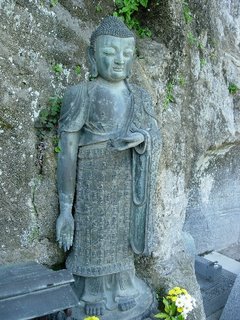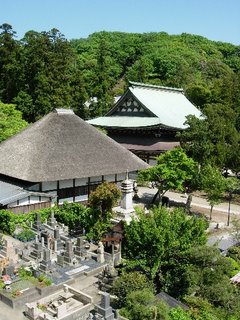Before I write about my visit to the Engaku-ji temple, I tell you a little bit of Kamakura's history.
The name Kamakura originates from the next theory. Fujiwara no Kamatari, the celebrated soldier and statesman of the seventh century, while on a pilgrimage to a distant shrine, passed one night at the little hamlet of Yui. Here he dreamed a sacred dream in which he was instructed by the powers above to bury his emblem, the "kama", or large sickle that he carried, upon a hill in the district. So, the district became known as the repository of the "kama", or Kamakura.
Kamakura was once the theater of a vast and densely populated city, thickly intersected with busy streets: studded with the splendid mansions of officials and retainers of the ruler; abounding in rich architecture and beautiful temples; in fact the most important city in the realm, the military capital of Japan.
This peaceful spot witnessed some of the most thrilling events in the feudal history of the nation; for, partly owing to the value of its strategic position, being entirely surrounded by mountains on three sides with the ocean on the south, an important consideration in those days, it was selected by the great Yoritomo as the base of his operations. In the year 1192, the first shogun of the Minamoto family was established in Kamakura.
Yoritomo caused the obscure little fishin hamlet to blossom into the most famous city of the day.
After quite some battles and intrigues he received the title of "shogun" from the emperor.Thus the dual system of government was established by which the emperor's authority was completely overshadowed, and which lasted for almost seven centuries, until the restoration of imperial power in 1868.
Simplicity and frugality, in strong contrast to the luxurious condition of society in Kyoto, the imperial capital, were Yoritomo's watchwords.

Yoritomo was of a sincerely religious nature. He attributed his many triumphs to his veneration and regard to the spiritual powers above. To this attitude Kamakura owed the large number of beautiful and important temples that were erected.
The power was usurped by the family of his wife when the line of Yoritomo became extinct. The rulers in this Hojo period were known as "shikken" or regents. The Hojo clan, weakened by the heavy costs of maintaining defences against the threats of attack from Kublai Khan in China, fell from power at the hands of the forces of Emperor Go-Daigo by the invasion of the general Nitta Yoshisada on July 5, 1333. The fidelity to their fallen ruler made more than six thousand people follow their lord in his death in a orgy of slaughter and extinction.

Although so many temples and shrines have been overtaken by various calamities and have disappeared since Kamakura's palmy days, yet there remain the considerable number of fourty Buddhist and nineteen Shinto temples.
The name Kamakura originates from the next theory. Fujiwara no Kamatari, the celebrated soldier and statesman of the seventh century, while on a pilgrimage to a distant shrine, passed one night at the little hamlet of Yui. Here he dreamed a sacred dream in which he was instructed by the powers above to bury his emblem, the "kama", or large sickle that he carried, upon a hill in the district. So, the district became known as the repository of the "kama", or Kamakura.
Kamakura was once the theater of a vast and densely populated city, thickly intersected with busy streets: studded with the splendid mansions of officials and retainers of the ruler; abounding in rich architecture and beautiful temples; in fact the most important city in the realm, the military capital of Japan.
This peaceful spot witnessed some of the most thrilling events in the feudal history of the nation; for, partly owing to the value of its strategic position, being entirely surrounded by mountains on three sides with the ocean on the south, an important consideration in those days, it was selected by the great Yoritomo as the base of his operations. In the year 1192, the first shogun of the Minamoto family was established in Kamakura.
Yoritomo caused the obscure little fishin hamlet to blossom into the most famous city of the day.
After quite some battles and intrigues he received the title of "shogun" from the emperor.Thus the dual system of government was established by which the emperor's authority was completely overshadowed, and which lasted for almost seven centuries, until the restoration of imperial power in 1868.
Simplicity and frugality, in strong contrast to the luxurious condition of society in Kyoto, the imperial capital, were Yoritomo's watchwords.

Yoritomo was of a sincerely religious nature. He attributed his many triumphs to his veneration and regard to the spiritual powers above. To this attitude Kamakura owed the large number of beautiful and important temples that were erected.
The power was usurped by the family of his wife when the line of Yoritomo became extinct. The rulers in this Hojo period were known as "shikken" or regents. The Hojo clan, weakened by the heavy costs of maintaining defences against the threats of attack from Kublai Khan in China, fell from power at the hands of the forces of Emperor Go-Daigo by the invasion of the general Nitta Yoshisada on July 5, 1333. The fidelity to their fallen ruler made more than six thousand people follow their lord in his death in a orgy of slaughter and extinction.

Although so many temples and shrines have been overtaken by various calamities and have disappeared since Kamakura's palmy days, yet there remain the considerable number of fourty Buddhist and nineteen Shinto temples.


0 Comments:
Post a Comment
<< Home